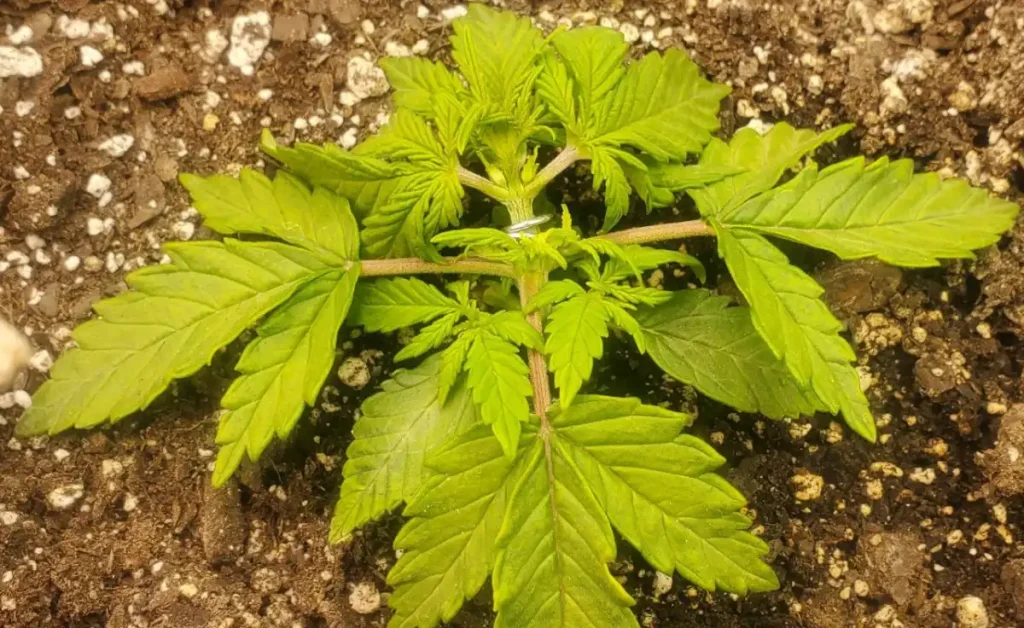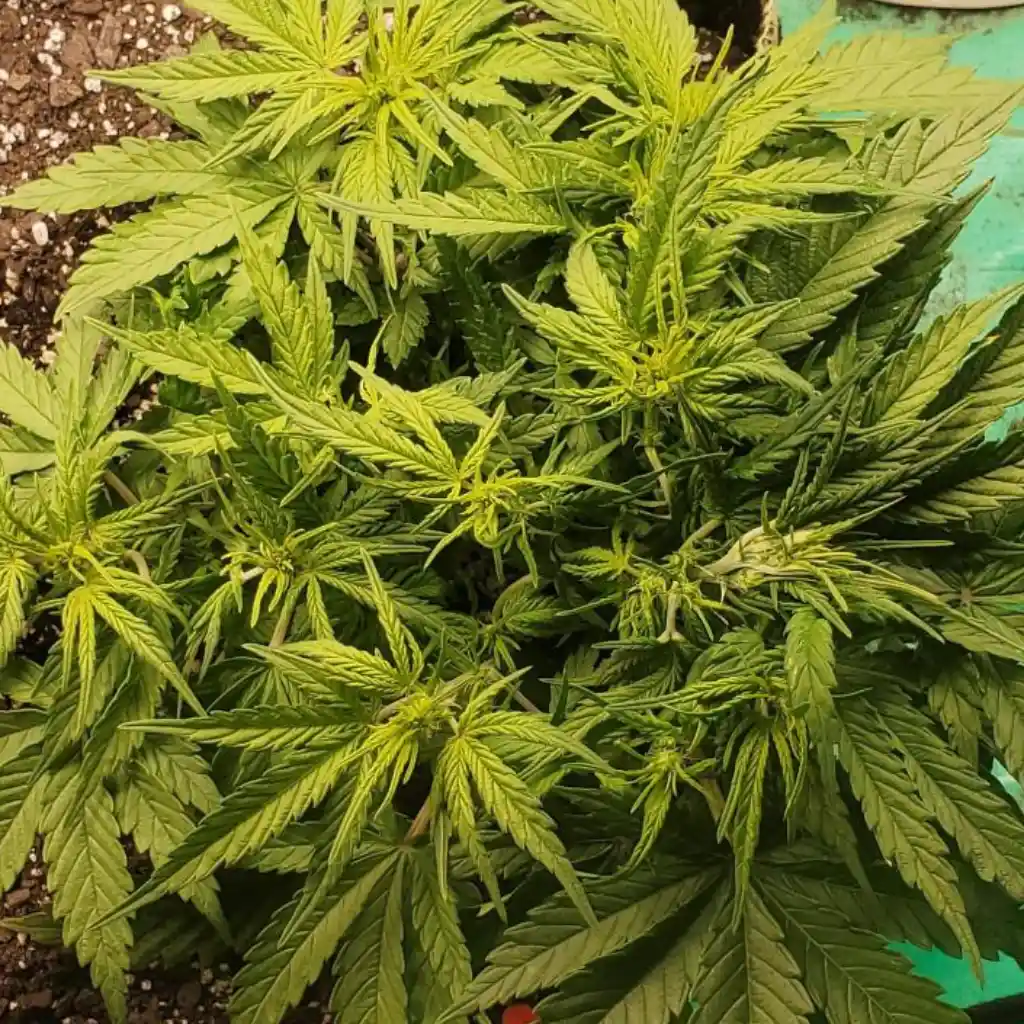The Californian Snow Auto strain is a unique autoflowering cannabis variety celebrated for its frosty white trichomes and refreshing citrus flavor. This strain is a result of crossing a Californian Sativa with a Ruderalis, giving it a balanced genetic profile. It is known for its uplifting effects, making it a perfect choice for daytime use. The compact structure and fast-growing nature of Californian Snow Auto make it a favorite among both novice and experienced growers.
With a compact structure and dense buds, Californian Snow Auto is perfect for both indoor and outdoor setups. The strain’s ease of cultivation and adaptability make it suitable for growers of all levels, offering consistent results.
Environmental Requirements for Growing Californian Snow Auto Strain
Californian Snow Auto thrives in environments with consistent temperatures between 68-77°F (20-25°C). Maintaining these conditions ensures optimal growth, promoting healthy development and preventing stress-related issues such as stunted growth or discoloration. Humidity levels should range from 50-60% during the vegetative phase to support foliage development. Gradually decrease humidity to 40-50% during flowering to avoid mold and mildew, particularly important given its dense trichome production. Adequate ventilation and air circulation are essential to prevent stagnant air and to support overall plant health.
Outdoors, Californian Snow Auto performs best in warm climates with plenty of sunlight. Its natural resistance to pests and diseases makes it a robust choice for growers in a variety of regions, including those with moderate climates. However, heavy rains and prolonged damp conditions can still pose risks. Regularly inspecting plants and providing appropriate support, such as stakes or cages, helps maintain their structural integrity. Growers should also ensure that soil conditions remain well-draining to avoid root issues, allowing this resilient strain to reach its full potential.
Setting Up The Growing Cannabis Space
Indoor Cannabis Cultivation
Indoors, provide Californian Snow Auto with high-intensity light from LEDs or HID systems. Full-spectrum LEDs are particularly effective, as they mimic natural sunlight and enhance cannabinoid and terpene production. A light cycle of 18/6 ensures the plant receives adequate light for photosynthesis while allowing rest periods for recovery and growth. Maintaining a consistent temperature and humidity range is critical; use fans and ventilation systems to achieve this. Choose a nutrient-rich soil or hydroponic setup to promote healthy root development. Keeping the water pH between 6.0 and 7.0 prevents nutrient lockout, ensuring that plants can absorb essential nutrients effectively.
Train the plant lightly, as its compact structure does not require aggressive pruning. Techniques like low-stress training (LST) can help maximize light exposure to lower bud sites without causing undue stress. Indoor growers benefit from Californian Snow Auto’s ability to adapt to various setups, including small grow tents and vertical gardening systems. Its manageable size and short flowering time make it a versatile strain for different growing techniques, ensuring high yields even in limited spaces
Outdoor Cannabis Cultivation
For outdoor cultivation, select a sunny location with well-draining, nutrient-rich soil. Californian Snow Auto requires at least 8 hours of direct sunlight daily to thrive. This ensures optimal photosynthesis, leading to vigorous growth and dense bud production. Its autoflowering traits allow it to adapt to various climates, but it performs best in warm environments. Protecting the plants from adverse weather conditions, such as heavy rains or strong winds, helps maintain their health and productivity. Using protective measures like windbreaks or temporary covers can prevent damage during unexpected weather changes.
Outdoor growers should also monitor soil nutrients closely, supplementing with organic fertilizers if necessary. Mulching around the base of the plants can help retain soil moisture and regulate temperature. Californian Snow Auto’s robust genetics make it an excellent choice for outdoor environments, producing high-quality yields even in challenging conditions. By following these guidelines, growers can achieve consistent results season after season.
Propagation and Germination of Californian Snow Auto Strain
Begin by germinating Californian Snow Auto seeds using the paper towel method. This method is simple and effective: dampen a paper towel, place the seeds inside, and store them in a dark, warm place with temperatures around 70-77°F (21-25°C). Within 24-48 hours, the seeds should sprout taproots, indicating they are ready for planting. Transfer the germinated seeds to small pots filled with light, airy soil to support root growth. Use a soil mix with good drainage properties to prevent waterlogging, which can harm the delicate seedlings.
Avoid overwatering during this stage, as excess moisture can lead to root rot or fungal infections. Instead, water lightly and consistently to maintain the right level of moisture. As the seedlings develop, gradually move them to larger pots to support their expanding root systems. Be cautious during transplantation to avoid disturbing the roots. This careful process ensures a healthy start for the plants, setting the stage for vigorous growth and high yields.
Vegetative Phase of Californian Snow Auto Strain
During the vegetative phase, focus on providing nitrogen-rich nutrients to encourage strong stems and lush foliage. Nitrogen is critical at this stage, as it supports chlorophyll production, which is essential for photosynthesis. Maintain a consistent 18/6 light cycle and monitor plants for nutrient deficiencies or pests. Signs of nutrient issues, such as yellowing leaves or slow growth, should be addressed promptly with appropriate supplements or adjustments to the feeding schedule.
Light defoliation may improve light penetration, although the strain’s compact structure minimizes the need for extensive pruning. Maintain humidity at 50-60% and ensure good airflow to support vigorous growth. Use fans or ventilation systems to circulate air around the plants, reducing the risk of mold or mildew. Proper care during this phase lays a solid foundation for a successful flowering period, ensuring robust and healthy plants.
Flowering Phase of Californian Snow Auto Strain
Californian Snow Auto transitions to flowering automatically after 3-4 weeks. During this phase, the plant shifts its energy from foliage growth to bud production. Switch to nutrients high in phosphorus and potassium to promote bud development and resin production. These macronutrients are vital for strengthening cell walls and enhancing the overall quality of the buds. Gradually reduce humidity to 40-50% to prevent mold and encourage trichome development, which is key to the strain’s potency and flavor.
Monitor the trichomes closely as the buds mature. Using a magnifying glass or jeweler’s loupe, observe the color changes in the trichomes. When most trichomes appear milky with a few turning amber, the plant is ready for harvest. Proper care during flowering enhances potency, flavor, and resin quality. Maintaining consistent conditions throughout this phase ensures a high-quality final product that reflects the strain’s full potential.
Cannabis Fertilization and Nutrition – Californian Snow Auto Strain
This strain benefits from a balanced nutrient schedule that adapts to its growth stages. During the vegetative phase, use fertilizers with higher nitrogen content to support leaf and stem development. A typical feeding schedule includes weekly applications of nutrient solutions, supplemented with organic additives to boost microbial activity in the soil. Consistent feeding during this stage promotes robust growth and prepares the plant for the transition to flowering.
In the flowering phase, transition to bloom-specific nutrients with increased phosphorus and potassium. These elements enhance bud density, flavor, and resin production. Avoid overfeeding, as Californian Snow Auto can be sensitive to nutrient burn. Always flush the plants with plain water in the final two weeks to remove excess salts and improve the flavor and quality of the buds. Flushing ensures a smooth smoking experience and preserves the strain’s natural terpene profile.
Pest and Disease Control for Cannabis Growing
Prevention
Prevent pests and diseases by maintaining a clean growing environment. Regularly sanitize tools and equipment to reduce the risk of contamination. Inspect plants frequently for signs of infestations, such as discolored leaves or unusual spots, and remove any affected foliage immediately. Using natural deterrents like neem oil or insecticidal soaps creates a protective barrier against common pests such as aphids and spider mites. Companion planting with herbs such as basil or marigold can also help repel pests while improving soil health.
Maintaining optimal humidity levels and proper airflow further reduces the risk of mold and mildew. Installing fans or ventilation systems ensures that air circulates freely, preventing stagnant conditions where pathogens can thrive. By implementing these preventive measures, growers can create a healthy environment that minimizes the risk of pest and disease outbreaks.
Corrective Actions
If pests or diseases appear, act quickly to minimize damage. For pests, introduce beneficial insects like ladybugs or predatory mites to control populations naturally. Organic insecticides and fungicides can also be applied to address specific issues without harming the plant or environment. Regular applications of these treatments can help keep infestations under control.
For fungal infections, improve airflow and reduce humidity levels immediately. Remove infected leaves or stems to prevent the spread of disease. Apply fungicides specifically designed for cannabis plants to treat affected areas. With prompt and effective corrective actions, growers can protect their crops and maintain high-quality yields.

Harvesting and Curing for Cannabis Growing
Californian Snow Auto is typically ready for harvest within 8-10 weeks from germination. Observing the trichomes is essential to determine the optimal harvest window; they should appear milky with some amber hues, while the pistils should be predominantly amber. Harvesting at this stage ensures maximum potency and flavor. Use sterilized tools to carefully trim the buds, removing excess leaves and stems. Handle the buds gently to preserve the delicate trichomes, which contain the majority of cannabinoids and terpenes.
Once trimmed, hang the buds upside down in a dark, well-ventilated area with temperatures between 60-70°F (15-21°C) and humidity around 50%. This drying process typically takes 7-10 days and is critical for preventing mold while retaining essential compounds. After drying, cure the buds in airtight jars to enhance their aroma and flavor. During the first week, open the jars daily to release excess moisture, then gradually reduce the frequency to once a week for the next few weeks. Proper curing ensures a smooth smoking experience and long-term preservation.
Is Californian Snow Strain Indica or Sativa?
Californian Snow Auto is a Sativa-dominant hybrid, offering uplifting and energizing effects. Its Sativa genetics are evident in its cerebral high, which boosts creativity and focus, making it an ideal choice for daytime use. The strain’s energizing effects can enhance productivity and inspire artistic pursuits, providing a clear-headed yet stimulating experience.
Despite its Sativa dominance, Californian Snow Auto also features calming properties inherited from its Ruderalis lineage. These traits provide a balanced effect, reducing anxiety and promoting relaxation without causing sedation. This combination makes it suitable for various activities, from socializing to completing creative projects.
Advantages of Growing Californian Snow Auto Strain
- Fast Growing: Ready for harvest in just 8-10 weeks.
- Compact Size: Suitable for small indoor spaces.
- Resilient: High resistance to pests and diseases.
- Flavorful: Refreshing citrus and sweet apple flavor.
Disadvantages of Growing Californian Snow Auto Strain
- Light Sensitivity: Requires precise light cycles for optimal growth.
- Nutrient Sensitivity: Prone to nutrient burn if overfed.
Problems in Cultivating Californian Snow Auto Strain
Common issues when cultivating Californian Snow Auto include overwatering and nutrient lockout. Overwatering can lead to root rot and stunted growth, so it is essential to allow the soil to dry out slightly between waterings. Using pots with adequate drainage and monitoring soil moisture levels can help prevent this issue. Nutrient lockout, caused by incorrect pH levels, can result in yellowing leaves and poor growth. Maintaining a pH range of 6.0-7.0 in soil and 5.5-6.5 in hydroponic systems ensures proper nutrient uptake.
Regularly inspecting plants for signs of stress or deficiency allows growers to address problems early. Adjusting the feeding schedule or using supplements like cal-mag can resolve minor deficiencies. Proper airflow and humidity control also reduce the risk of mold and mildew, particularly during the flowering phase when buds are dense and resinous.
Advanced Pest Control for Cannabis Growing
For persistent pest problems, advanced methods such as introducing predatory insects can provide effective solutions. Parasitic wasps, ladybugs, and predatory mites naturally control pests like spider mites, aphids, and whiteflies without harming the plants. These beneficial insects create a balanced ecosystem, reducing the need for chemical interventions.
Applying systemic organic pesticides, such as those derived from neem oil or pyrethrin, can target severe infestations while remaining safe for cannabis plants. Combining these methods with an Integrated Pest Management (IPM) approach, which includes regular monitoring, environmental controls, and crop rotation, minimizes pest risks and ensures healthier plants. Advanced pest control techniques protect yields and improve overall plant resilience.
Similar Strains
Lemon Haze Auto
Lemon Haze Auto is a Sativa-dominant strain renowned for its zesty citrus aroma and uplifting effects. Its genetic lineage includes Lemon Skunk and Haze, resulting in a vibrant flavor profile with sweet and tangy notes. This strain provides a clear-headed high that enhances focus and energy, making it ideal for daytime use. Lemon Haze Auto is also known for its resilience, making it a great option for both novice and experienced growers.
Pineapple Express Auto
Pineapple Express Auto delivers tropical, fruity flavors reminiscent of pineapple and mango. This hybrid strain offers a balanced high that combines the uplifting effects of Sativa with the calming properties of Indica. Its fast flowering time and robust genetics make it a popular choice among growers. The strain’s euphoric and relaxing effects make it perfect for unwinding after a long day or enjoying a creative session. Pineapple Express Auto consistently produces high-quality yields, even in less-than-ideal conditions.
Week-by-Week Growth Plan for Californian Snow Auto Strain
Week 1-2: Germination and Early Seedling Stage
Focus on maintaining warm, humid conditions. Keep soil moist but not waterlogged. Provide a gentle light source, ensuring seedlings develop sturdy stems and healthy roots. Avoid stress during this period.
Week 3-4: Vegetative Growth
Increase light intensity and begin feeding with nitrogen-rich nutrients. Monitor humidity and airflow. Plants should display vigorous growth with strong stems and healthy foliage. Avoid overwatering.
Week 5-8: Flowering Stage
Switch to bloom nutrients high in phosphorus and potassium. Gradually reduce humidity and maintain airflow. Observe trichome development to determine optimal harvest timing. Plants should develop dense, resinous buds.
Week 9: Harvest
Flush plants with plain water for two weeks before harvest to enhance flavor. When trichomes are mostly milky with some amber, cut and cure the buds in a cool, dark place. Proper curing preserves flavor and potency.
FAQs
What is the THC percentage of Californian Snow Auto strain?
Californian Snow Auto typically has a THC content of 18–23%, offering a potent yet balanced high suitable for both recreational and medicinal users. This level of THC provides uplifting and energizing effects without being overwhelming, making it accessible to users of varying experience levels. Its balanced potency ensures a clear-headed experience, perfect for daytime use or social settings. For those seeking similar balanced effects, the Sensi Skunk Automatic is also a great option, offering a smooth high with approachable potency.
How long does Californian Snow Auto take to grow?
Californian Snow Auto completes its life cycle in approximately 8-9 weeks from germination. This rapid growth makes it an excellent choice for growers seeking quick harvests without sacrificing quality. Its autoflowering nature eliminates the need for strict light schedules, simplifying the growing process for beginners. Despite its fast-growing traits, the strain produces dense, resinous buds that rival those of longer-flowering varieties.
Can Californian Snow Auto be grown in cold climates?
Yes, Californian Snow Auto can be grown in cold climates, but results may vary. While the strain demonstrates resilience and adaptability, it performs best in warm, sunny conditions. In colder regions, growers can use a greenhouse or indoor setup to maintain consistent temperatures and protect the plants from frost. Proper insulation, supplemental lighting, and humidity control are essential for maximizing yields in less favorable climates.
What flavors and terpenes are present in Californian Snow Auto strain?
This strain features a refreshing flavor profile dominated by citrus and apple notes, providing a crisp and enjoyable smoking experience. The terpene profile includes limonene, which contributes to the citrus aroma, and myrcene, known for its earthy undertones and relaxing effects. Together, these terpenes create a harmonious blend of uplifting and calming sensations, enhancing both flavor and therapeutic potential.
What are the medicinal benefits of Californian Snow Auto strain?
Californian Snow Auto may help alleviate stress, anxiety, and fatigue, making it suitable for daytime therapeutic use. Its uplifting effects promote mental clarity and focus, while its relaxing undertones help ease tension without causing sedation. Users report improved mood and energy levels, making it a valuable option for managing mild depression or chronic fatigue. Additionally, its quick onset and balanced effects make it ideal for individuals seeking immediate relief without interfering with daily activities.





